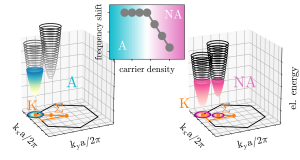This website uses cookies to ensure a better user experience.
To get more information, please read our Cookie Statement.
Broken adiabaticity induced by Lifshitz transition in MoS2 and WS2 single layers
Dino Novko, research associate at the Institute of Physics, published a paper in the prestigious journal Communications Physics, where he proved that the adiabatic Born-Oppenheimer approximation is not valid in transition metal dichalcogenides. Specifically, the results show that in these materials, a strong nonadiabatic phonon renormalization is triggered at the Lifshitz transition. Knowledge of these intricate dynamic effects is critical to fully understand the characterization of doped two-dimensional nano-devices by means of Raman spectroscopy.
Broken adiabaticity induced by Lifshitz transition in MoS2 and WS2 single layers
Dino Novko, Communications Physics 3, 30 (2020).
DOI: 10.1038/s42005-020-0299-1
One of the most impressive repercussion of the dynamical interplay of electrons and phonons on lattice vibrational spectrum is nonadiabatic frequency renormalization. Comprehending the microscopic processes behind this spectral changes is of great importance. For instance, in graphene-based transistors, where adiabatic Born-Oppenheimer approximation is not valid anymore, accounting for the nonadiabatic coupling is crucial for quantitative estimations of electron concentration by means of Raman spectroscopy. These dynamical effects are, however, considered quite rare and are only present in few systems, like graphene, graphite intercalation compounds, MgB2, and boron-doped diamond. The electron-phonon coupling in other layered and atomically-thin materials is regarded to be fully adiabatic. Semiconducting transition metal dichalcogenides when doped with holes and electrons are believed to fall in the latter, adiabatic regime. Contrary to the common belief, it is shown here that the remarkable breakdown of the adiabatic approximation happens in doped MoS2 and WS2 monolayers. The corresponding nonadiabatic mechanism is even more intricate than in the case of graphene. Namely, the abrupt adiabatic-nonadiabatic crossover, and the ensuing phonon frequency renormalization, occur at the outset of the Lifshitz transition, i.e., when the Fermi level crosses two or more conduction or valence band valleys. Furthermore, the topology of these valleys, and thus the amount of carrier concentration required to cross multiple valleys and induce the nonadiabatic effects are dictated by the highly non-local electron-electron interaction and spin-orbit coupling. Also, these significant dynamical effects are accompanied by the intense electron-hole pair scatterings due to electron-phonon coupling, which are shown to be responsible for the experimentally-observed phonon linewidth modifications due to doping. All in all, the present results of dynamical effects in doped transition metal dichalcogenides are expected not only to be relevant for comprehending the corresponding Raman measurements, but as well for deciphering other physical phenomena observed in these two-dimensional materials where electron-phonon coupling plays a crucial role, e.g., phonon-limited mobility and superconductivity.





